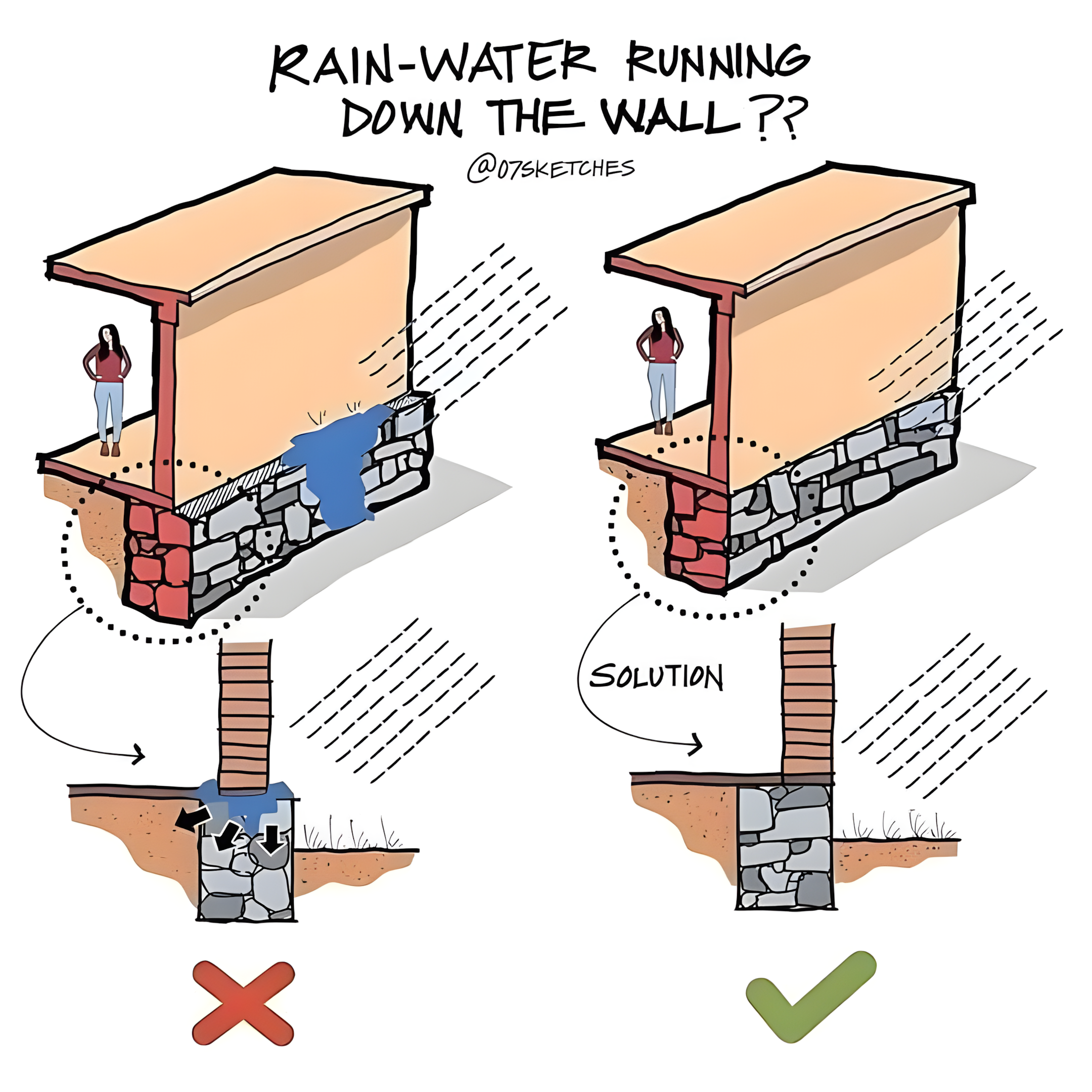A simple architectural tweak can save buildings from costly damage caused by rainwater running down exterior walls.
🌧️ The Hidden Enemy: Rainwater
When people think of rain, they often imagine fresh water replenishing the earth, filling rivers, and cooling the environment. But for homeowners and builders, rain can also be a destructive force. One of the most common yet underestimated problems is rainwater running down walls.
At first, it might look harmless: water trickling down after a shower. But over time, this consistent flow leads to serious damage:
- Damp walls and peeling plaster.
- Mold and mildew growth, creating health hazards.
- Weakening of structural foundations as water seeps into masonry.
- Increased maintenance costs for homeowners.
This problem is especially severe in regions with heavy or prolonged rainfall.
🏚️ The Wrong Way: What Happens Without Proper Design
The left side of the diagram shows the wrong approach. Here’s what happens step by step:
- Rainwater hits the roof and immediately begins flowing downward.
- Instead of being guided away, the water runs directly along the exterior walls.
- The wall surface absorbs some of the moisture, while the rest trickles down into the foundation.
- Over time, the wall and foundation become saturated, leading to damp patches inside the house.
The result? Cracks, weakened bricks, decaying mortar, and even water rising through capillary action into living spaces. This is not just cosmetic damage — it’s a structural hazard.
✅ The Right Way: The Smart Solution
On the right side of the diagram, the solution is shown — and it’s surprisingly simple.
Instead of allowing rain to wash down the wall, architects and builders can design a protective projection at the roof edge, sometimes called:
- Overhangs
- Drip edges
- Chajjas (in Indian architecture)
How it Works:
- Rainwater falls on the roof.
- The overhang directs water away from the wall’s surface.
- Water drops freely to the ground instead of clinging to the wall.
- The wall remains dry, protected, and durable.
This small design change ensures that walls are shielded from constant water contact, dramatically extending the lifespan of the building.
🧱 Why This Matters: Protection Beyond Walls
Preventing rainwater from running down walls is not just about keeping walls dry — it has multiple benefits:
- Structural Safety
- Dry walls retain their load-bearing strength.
- Foundations stay free from waterlogging.
- Health & Comfort
- Dry interiors mean no mold or damp smell.
- Prevents respiratory issues linked to fungus.
- Aesthetics
- Exterior paint and finishes last longer.
- No ugly stains or peeling plaster.
- Economic Value
- Reduces repair and repainting costs.
- Increases property value due to better durability.
🌍 Traditional Wisdom in Architecture
Interestingly, many traditional building practices already solved this problem centuries ago:
- Japanese homes use extended eaves to protect wooden walls from rain.
- Mediterranean houses feature sloped tiled roofs with drip edges.
- Indian vernacular houses often include deep chajjas and verandas for shading and rain protection.
These features were not just aesthetic — they were practical responses to local climates.
Modern construction, however, sometimes overlooks these principles in favor of minimalist designs. The result? Beautiful homes that fail to withstand the elements.
🔧 How Builders Can Apply This Today
To prevent rainwater damage, architects and engineers recommend:
- Roof Overhangs: Extend the roof edge at least 18–24 inches beyond walls.
- Drip Edges or Gutters: Install metal or PVC drip strips to guide water away.
- Waterproof Plastering: Apply water-repellent coatings on exterior walls.
- Proper Ground Drainage: Ensure water falling off the roof does not pool near foundations.
These low-cost additions can save thousands in future repairs.
🌦️ The Climate Factor
With climate change, rainfall patterns are becoming more intense and unpredictable. Urban areas face flash floods and torrential rains that overwhelm buildings. In such scenarios, poorly designed walls act like sponges, soaking up water and accelerating decay.
Therefore, rain-resilient design is no longer optional — it’s a necessity.
🏠 Homeowner Awareness
Many homeowners are unaware of this problem until it’s too late. Spotting early warning signs is crucial:
- Damp spots appearing inside walls.
- Paint bubbling or flaking.
- Musty smell indoors.
- Water stains on exterior walls.
Catching these signs early allows homeowners to retrofit solutions, such as installing drip edges or redoing waterproof plaster.
📢 Final Takeaway
The lesson from this diagram is simple yet powerful:
👉 Rainwater should never run down your walls.
With smart architectural design — roof overhangs, drip edges, and good drainage — homes can stay dry, strong, and healthy for decades.
Rainwater is a gift of nature, but when ignored in construction, it becomes a silent destroyer. Protecting walls from water is one of the easiest and most cost-effective ways to ensure sustainable living.
As cities expand and climates grow harsher, adopting these time-tested rainproofing techniques will be essential in building homes that truly stand the test of time. 🌧️🏡
